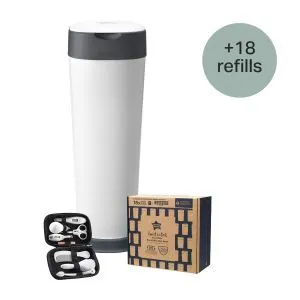
Ultimate XL Nappy Disposal Bundle with 18 Refills
Bundle & Save 40%
Subscription orders can be cancelled at anytime. Free delivery on all subsequent subscription orders. Find out more about subscriptions.
They’re easy and fuss free
Your products are automatically sent to you
You save up to 10% when you sign up for a subscription
You can cancel at any time

The gentle rise and fall of your baby's chest against yours, the warmth of their little body snuggled close – for many new parents, contact naps are a familiar and often cherished experience.
But beyond the cosy cuddles, are there genuine benefits to letting your baby snooze in your arms? And what about the potential drawbacks? This blog explores the pros and cons of contact naps to help you decide if this popular practice is the right fit for you and your baby.
Explore the Range
The decision of when to stop contact naps is personal, often guided by a baby's developmental cues, parental well-being, and practical considerations. Most parents stop contact naps between 4 and 12 months, with a gradual transition often being the most successful approach while always prioritising safe sleep practices for independent sleep.
Ultimately, the best time to stop contact naps is when it feels right for both you and your baby. Pay attention to your baby's cues and your own needs and make the transition at a pace that feels comfortable for everyone.
Stopping contact naps is often a gradual process, as it involves helping your baby transition from needing you to fall asleep to being able to nap independently.
Every baby is different. Some may naturally transition to independent napping more easily than others, regardless of their early napping habits.
Here are our top five tips to make the process smoother for you and your baby.
The key is consistency and giving your baby time to adjust to the new sleep method. It may take a little while, but with patience, they'll likely get the hang of it.
Babies typically outgrow contact naps as they grow and develop better self-soothing skills. Here's a general timeline for when babies usually move away from contact naps.
Like contact napping, Kangaroo Care is a practice that involves skin-to-skin contact with newborns and has benefits like improved physiological stability (heart rate, temperature, breathing), reduced crying, and enhanced bonding. Kangaroo care is often skin-to-skin and used in NICU settings.